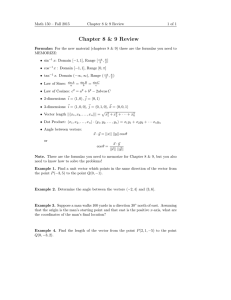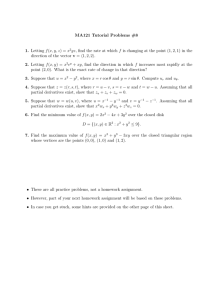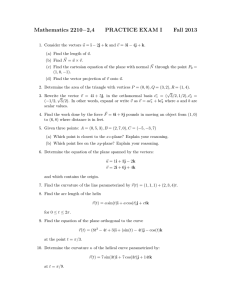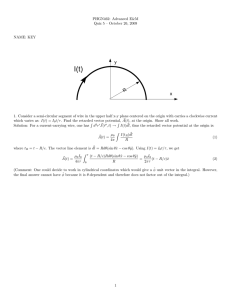Course1_Plan and Problem Sets
advertisement
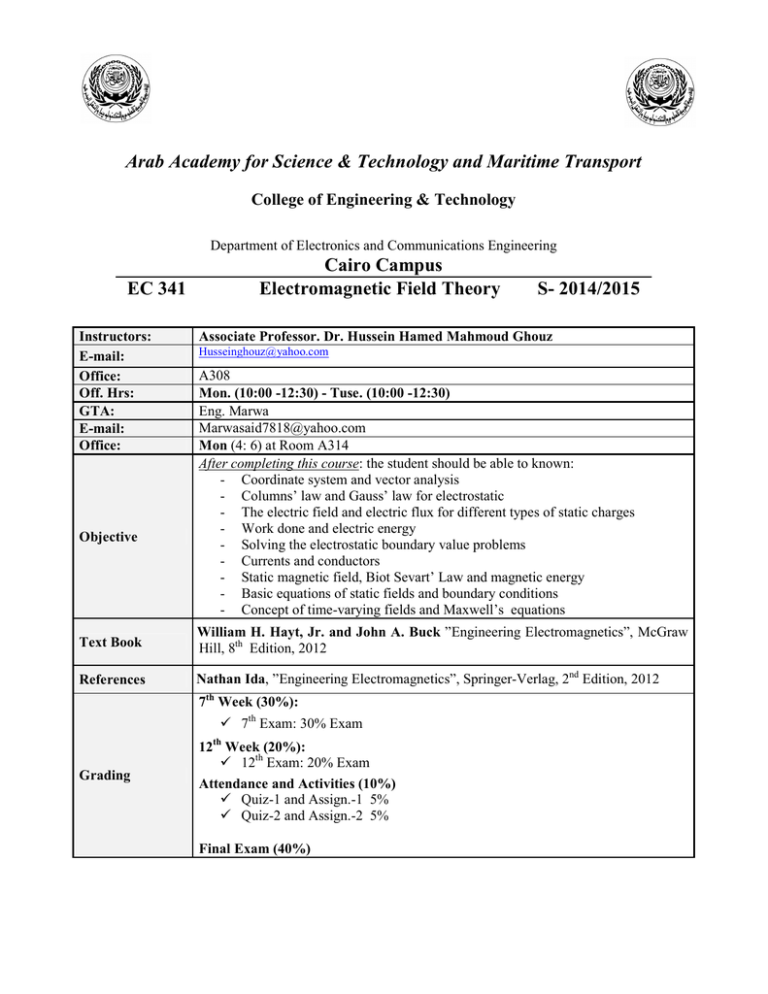
Arab Academy for Science & Technology and Maritime Transport
College of Engineering & Technology
Department of Electronics and Communications Engineering
EC 341
Instructors:
E-mail:
Office:
Off. Hrs:
GTA:
E-mail:
Office:
Objective
Cairo Campus
Electromagnetic Field Theory
S- 2014/2015
Associate Professor. Dr. Hussein Hamed Mahmoud Ghouz
Husseinghouz@yahoo.com
A308
Mon. (10:00 -12:30) - Tuse. (10:00 -12:30)
Eng. Marwa
Marwasaid7818@yahoo.com
Mon (4: 6) at Room A314
After completing this course: the student should be able to known:
- Coordinate system and vector analysis
- Columns’ law and Gauss’ law for electrostatic
- The electric field and electric flux for different types of static charges
- Work done and electric energy
- Solving the electrostatic boundary value problems
- Currents and conductors
- Static magnetic field, Biot Sevart’ Law and magnetic energy
- Basic equations of static fields and boundary conditions
- Concept of time-varying fields and Maxwell’s equations
Text Book
William H. Hayt, Jr. and John A. Buck ”Engineering Electromagnetics”, McGraw
Hill, 8th Edition, 2012
References
Nathan Ida, ”Engineering Electromagnetics”, Springer-Verlag, 2nd Edition, 2012
7th Week (30%):
7th Exam: 30% Exam
Grading
12th Week (20%):
12th Exam: 20% Exam
Attendance and Activities (10%)
Quiz-1 and Assign.-1 5%
Quiz-2 and Assign.-2 5%
Final Exam (40%)
Course Plan
1. Coordinates systems and vector analysis (1-Lecture)
• Coordinates systems - Vector operations - Vector analysis
2. Static Electric Field (5-Lectures)
• Column's law for electric force
• Electric field and electric flux in free-space
• Gauss' Law
• Work Done and Electrostatic Potential
• Electric Dipole
• Dielectrics and Polarization
• Boundary condition of static electric field
• Basic Equations of Static Electric Field
• Capacitance
---------------------------------------------------------------------------------------------------7th Exam
---------------------------------------------------------------------------------------------------3. Electrostatic Problems (2-Lectures)
• Image Method
• Boundary Value Problems and Laplace and Poisson Equations
4. Currents and Conductors (1-Lecture)
• Ohm' Law
• Joule' Law
• Resistance
• Boundary condition of stationary currents density
---------------------------------------------------------------------------------------------------12th Exam
---------------------------------------------------------------------------------------------------5. Static Magnetic Field (3-Lectures)
• Basic Equations of Static Magnetic Field
• Ampere's Law - Biot-Savart Law - Magnetic Vector Potential
• Boundary condition of static magnetic field
• Magnetic Force
• Inductance
6. Time-Varying Fields and Maxwell's Equations (1-Lectures)
• Faraday' Law
• Displacement Current
• Maxwell' Equations
• Time-Harmonic Fields
• Uniform Plane Wave
---------------------------------------------------------------------------------------------------Final week 16th
---------------------------------------------------------------------------------------------------2
Exercise and Quiz Test Plan
Problem Set No.
Week No.
Quiz Test
Problem set # 1
Problem set # 2
1st 2nd, 3rd & 4th
Week
Problem set # 3
5th & 6th Week
Problem set # 4
Problem set # 5
1st Quiz 5th Week
8th , 9th & 10th Week
11th, 13th & 14th Week
3
2nd Quiz 10th Week
1. Coordinate Systems and Vector Analysis
∇ V=
VVVV
∇2
=
∂V
a
h1∂u1 u1
∂V
∂V
a
a
+
h 2 ∂u 2 u2
h 3 ∂u 3 u3
+
∂
1 ∂V
+ ∂ h h 1 ∂V + ∂ h h 1 ∂V
h
h
h 1 h 2 h 3 ∂u1 2 3 h1 ∂u1 ∂u2 1 3 h 2 ∂u 2 ∂u3 1 2 h 3 ∂u 3
1
AAAA
∂
∂
∂
(h 2 h 3 A 1 ) +
(h 1 h 3 A 2 ) +
(h 1 h 2 A 3 )
∂
u
1
u
2
u
3
∂
∂
h 1h 2 h 3
1
∇.
=
∇X
h1au1
∂
1
A=
h1h 2h 3 ∂u1
h1 A u1
h 2a u2
∂
∂u2
h 2 A u2
∫ ∇ • A dv = ∫ A • ds
v
s
Divergence Theorem:
Stokes's Theorem:
h 3a u3
∂
∂u3
h 3 A u3
∫ (∇ × A ) • ds = ∫ A • dl
s
c
Metric coefficients of Coordinate systems
(x, y, z)
(ρ, Φ, z)
(r, θ, Φ)
au1
ax
aρ
ar
au2
ay
aΦ
aθ
au3
az
az
aΦ
h1
1
1
1
h2
1
ρ
r
h3
1
1
r sin θ
Transformation between Coordinate Systems
4
ax
ay
az
•
•
•
aρ
cosΦ
sinΦ
0
aΦ
-sinΦ
cosΦ
0
az
0
0
1
ar
sinθ cosΦ
sinθ sinΦ
cosθ
aθ
aΦ
cosθ cosΦ -sinΦ
cosθ sinΦ cosΦ
-sinθ
0
Integral Forms
Integral Form
Result of Integration
ln( x + x2 + a2)
sinh −1 xa
dx
x2 + a 2
xdx
∫
x2 +a 2
∫
x2 + a 2
dx
∫ 2 2 3/ 2
(x + a )
x
a 2 x2 + a 2
x dx
∫ 2 2 3/ 2
(x + a )
dx
∫ 2 2
( x +a )
−1
x2 + a 2
1 tan-1 x
a
a
xdx
∫ 2 2
( x +a )
1
ln(x2 + a2)
2
dx
∫
x (x 2 + a 2 )
− 1 ln
a
2
2
a + x + a
x
1 ln tan ax
a
2
dx
∫ sin ax
5
Differential Calculus
Function
Differentiation
sin(x)
cos(x)
cos(x)
-sin(x)
tan(x)
sec2(x)
1
sin(x)-1
1−x2
-1
cos(x)-1
1−x2
tan(x)-1
1
1 + x2
ex
ex
ln(x)
1/x
loga(x)
1/[x ln(a)]
Trigonometric relations
sin(x) = 1/2(1 - cos(2x))
cos(x) = 1/2(1 + cos(2x))
tan(x) =
(1 - cos(2x))
cos( x)
sin(2x) = 2 sin( x) cos( x)
sin(x ± y) = sin( x) cos( y) ± cos( x) sin( y)
cos(x ± y) = cos( x) cos( y) m sin( x) sin( y)
e ± jx = cos( x) ± j sin( x)
6
2. Static Electric Field
1. Coulomb’s law:
q
F2 = k
1
q
R2
2 a , Where, k=1/(4πε )= 9x109, and ā is the unit vector in the
0
R
r
direction of the force ( ar = âr =ār= r / r ). If the force is negative, it is attraction
force, while the positive sign means repulsion force.
2. Electrostatic Field and Potential (E and V):
r
E
Point
E
Line
E
Surface
E
Volume
P
=
P
P
P
=
=
=
qi
4 π ε o Ri 2
1
4π ε o
∫
r
R
V
ρ r
R3
R d l′
V
ρs r
R ds ′
∫∫
4 π ε o s R3
1
ρv r
R dV ′
∫∫∫
4 π ε o v R3
1
r
Ep = −∇VP
and
V
V
Vp = −
P
P
P
P
=
=
=
=
qi
4 π ε o Ri
1
4π ε o
1
∫
∫∫
4π ε o s
1
∫∫∫
4π ε o v
ρ
R
d l′
ρs
R
ρv
R
ds ′
dV ′
r
P r
E
•
∂
∫
P l
Ref
The Ref. point usually have a zero potential
3. Gauss’s law:
∫ D.n ds = Q (total charge enclosed)
s
Where;
Q = ∫∫∫ ρ v dv
v
= ∫∫ ρs ds
s
= ∫ ρl dl
volume charge
surface charge
line charge
7
2
∫ D.n ds = 4πr Dr for sphere of radius r
s
= 2πρ l Dρ for cylinder of radius ρ and length l
4. Boundary Condition of electric field (air-conductor interface):
E
ρs
=
n
E = 0
t
and
εo
5. Finite Line charge:
EP =
L/2
2 π εoρ
2
2
ρ + ( L / 2)
VP =
ρ 2 + ( L / 2) 2 + L / 2
ln
ρ
2 π εo
ρl
aρ
ρl
6. Infinite Line Charge:
EP =
ρl
VP =
and
a
2 π ε oρ ρ
ρl
2 π εo
ρ
ln o
ρ
7. Electric Dipole:
V=
p cos θ
and E
4 π ε or 2
=
1
4 π εo r 3
(2 p cos θ a + p sin θ a )
r
θ
8. Basic Equations of Static Electric Field
∇.D = ρ
∇ × E=0
9. Polarization vector P:
P=D −ε
o
E = ( ε − 1) ε E
r
o
10. Boundary Conditions of Electric Field (dielectric-dielectric interface):
E1t = E2t
and
D1n − D2n = ρs
(where, ρs is free charge)
11. Capacitance:
C=
Q
V
Where;
8
ρ v dv = Q )
Q is the Gauss’s law ( ∫ D. n ds = ∫∫∫
s
v
V is the line integral of E along the path
( Vab =
−
int ial = a
E . dl =
∫
final = b
Va - Vb)
To find the capacitance, we follow the 4-steps:
1. Assume a charge +Q and -Q on the two conductors.
2. Find E using Gauss’s law or any other method.
3. Find V using line integral along E lines
4. Put Q = C V, and then Find C.
12. Electrostatic Energy:
For N-discrete charge:
We =
Where,
n
1
∑ Q k Vk
2 k =1
1
V =
k
4π ε
o
n Qj
∑
j = 1 Rjk
and j ≠ k
For continuous charge:
We =
1
ε
∫∫∫ ( D . E ) d v ′ =
∫∫∫ E
2 v'
2 v'
2
d v′
For any capacitor configuration:
1
1
Q2
W =
C V2 =
QV =
e
2
2
2C
Surface bounded charge for any capacitor configuration:
ρUpper = First Conductor = P • (−an )
ρ
Lower
= Second Conductor = P • ( + a )
n
9
3. Solution of Electrostatic Problems
1.Image Method:
z
z
+Q
P
R1
Conducting plane (PEC)
h
y
+Q
R2
y
-Q
x
Fig.1 (a)
Fig.1 (b)
+Q
-Q
+Q
+Q
-Q
Fig.2 (b)
Fig.2 (a)
If the conductor is in the form of corner with an angle “α”, then in this case, we
have m images where,
m = 2n -1 and n =
180
α
2. Boundary Value Problems
In Cartesian:
2
∂2
∂2
∂
∇2 V =
+
+
Vp = 0
P 2
2
2
∂y
∂z
∂x
The possible solutions of W ' ' (u) + k 2u W(u) = 0
10
k2
u
k
0
0
+
k
W(u)
u
Linear Solution
Ao u + Bo
Periodic Solution
A1 sin (k u) +B1 cos (ku)
C1 e+j k u + C2 e-j k u
Decayed Solution
-
jk
A2 sinh (ku)+B2 cosh (ku)
D1 e+ k u + D2 e- k u
In cylindrical:
2
∇ V=
1 ∂
∂V
1 ∂ 2V
∂ 2V
(ρ
)+
= 0
+
ρ ∂ρ
∂ρ
ρ 2 ∂φ 2
∂Z 2
In case of Φ-dependence solution is given as:
Φ (Φ) = Ao Φ + Bo
In case of ρ-dependence solution is given as:
dV(ρ)
d
(ρ
)=0
dρ
dρ
⇒
V (ρ) = A1 ln (ρ) + A2
In Spherical:
∇2 V =
1 ∂
1
∂V
∂
∂V
(r 2
)+
( sinθ
) = 0
2
2
∂
r
∂
r
∂
θ
∂
θ
r
r sin θ
(a) In case of r-dependence only:
1 d
dV
(r 2
)= 0
2
r
r
d
d
r
⇒
V(r, θ, Φ) ≡ V(r)
Then:
d
dV
(r 2
) = 0
dr
dr
dV A1
=
dr r 2
⇒
⇒
(r 2
dV =
dV
) = A1
dr
A1
dr
r2
11
-1
V(r) = A1 + A2
r
The constant A1 and A2 are determined from the given BC.
(b) In case of θ-dependence only:
d
dV
( sinθ
) = 0
dθ
r 2 sin θ dθ
1
dV A 1
=
dθ sin θ
Since the integration ∫
⇒
⇒
sin θ
dV = ∫
dV
= A1
dθ
A1
sin θ
dθ
dx
1
ax
= ln tan
, therefore, the electric potential is given as:
sin ax a
2
θ
V(θ) = A1 ln tan + A2
2
Where, the constant A1 and A2 are determined from the given BC
4. Currents and Conductors
1. Ohm’s law:
In any conducting medium, if an electric field is applied, a current density J is
given by:
J= σE
Where,
σ
Denotes conductivity of the conductor
J
Denotes current density A/m2
σ =
J
A/m 2
=
=
E
V/m
moh (siemens)
A
=
= S/m
V m
m
The total current passing through an arbitrary surface S of a conducting body
is given by
12
I = ∫∫ J . ds
s
2. Resistance:
R=
V
I
2
∫ E . dl
R= 1
σ ∫∫ E . ds
s
→
(a) The voltage V is applied along the coordinate u1 while the current is passing
across the surface of the plane u2-u3.
L
R=
∫
o
σ
∫∫
du 1
h 2h3
du 2 du 3
h1
(b) Solving Laplace Equation
1. Find the electric potential V
2. Find the electric field as E = − ∇ V
3. Find the current density J = σ E
4. Find the total current I = ∫∫ J . ds
s
5. Find the resistance R as R =
V
I
3. Duality Law:
There is a dual relation between the resistance and the capacitance as:
resistance
x capacitance
64748
R x C
=
ε
σ
{
ratio of the constitutive parameters
of the conducting medium
13
Duality between J and D
Conductor
Dielectric
J = σE
D = εE
∇. J = o
∇. D = o
Jn1 = Jn2
Dn1 = Dn2
J t1 J t 2
=
σ1 σ 2
D t1 D t 2
=
ε1
ε2
σ
ε
I
Q
1
= G
R
C
5. Static Magnetic Field
Basic Equations of Static Magnetic Filed:
•
∇ . B = 0 , ∇ x H = J , and B = µ H
Ampere's Law
•
∇ x B = µo J
•
∫ B. dl = µ o I
c
Differential form
Integral form
Biot-Savart Law for a line carrying constant current:
•
H= ∫
L
I dl x a R
4 π R2
For finite Line carrying constant current:
H=
I
[ sin (the angle in current direction) − sin (the angle in oppsite current direction) ]aˆ n
4πd
Magnetic Vector Potential for a line carrying constant current:
•
A = ∫
c
µ o I dl
4πR
Loop of constant current I and radius r=b:
14
•
H
center
=
I
( ±a z )
4b
Boundary Conditions:
H1L = H2L
B1n = B2n
→
→
H1t = H2t
µ1 H1n = µ2 H2n
In case of current existing at the boundary surface:
H1t - H2t = Js
Magnetic Force Fm:
F12 = ∫ I 2 d l 2 x B1
c
and
F = ∫ I dl x B
21
1 1
2
c
Magnetostatic Energy:
Wm =
2
1
µ
∫∫∫ ( B . H ) d v ′ =
∫∫∫ H
2 v'
2 v'
d v′
Inductance L:
To find the inductance of any geometry, we should do the following steps:
1. Choose the suitable coordinate system, and assume source current I.
2. Find the magnetic field density B (or H)
- Ampere’s Law (if there is a symmetry)
- Biot-Savart Law
- Magnetic vector potential B = ∇ x A
3. Find the magnetic flux ψ as ψ =
∫∫
s
4. Find the flux linkage Λ = ψ N
5. Find L as L = Λ / I
15
B . ds
6. Maxwell’s Equations for Time-Varying Fields
Differential form
∇xE=−
∂B
∂t
∇ xH = J+
∂D
∂t
Integral form
E. dl = −
∫
∫
∫∫
∂B
. ds
∂t
∂D
. ds
∂t
H. dl = I + ∫∫
∫
∇.D = ρ
D. ds =
∫
∇.B = 0
∫∫∫
ρ dv
B. ds = o
D=εE
B=µH
J =σE
Maxwell’s Equations for complex Time-Harmonic Fields
•
∇ x E =− j ω µ H
•
∇ x H = − jω ε E + σ E
•
∇ . E = ρ/ ε
•
∇. H =0
•
•
D=ε E
•
•
•
•
•
•
→
Differential form
B= µ H
∫ E • d l = − jωµ ∫∫ B • d s
s
∫ H • d l = (− jωµ + σ ) ∫∫ E • d s
s
∫∫ E • d s = Q / ε
s
∫∫ B • d s = 0
s
→
Integral form
D=ε E
B= µ H
16
Problem Set #1
P.1-1 Three corners of a triangle are at P1 (0, 1, -2), P2 (4, 1, -3), and P3 (6, 2, 5).
a) Determine whether the triangle P1P2P3 is a right triangle.
b) Find the area of the triangle.
P.1-2 Given the vector A =3ax + 4ay – 6az in cartesian. Express this vector in the
following coordinate systems:
a) Cylindrical coordinate system.
b) Spherical coordinate system.
P.1-3 A vector field F is expressed in spherical coordinates as:
F = (25/r2) ar.
a) Find | F | and Fx at the point P (-3, 4, -5).
b) Find the angle that "F" makes with the vector B =2ax - 2ay +az at the point P.
P.1-4 Given the vector field function F = x2y ax + xy2 ay , evaluate the scalar line
integral ∫ F.dl
from the point P1(2, 1, -1) to the point
P2 (8, 2, -1)
c
a) Along the parabola x=2y2
b) Along the straight line joining the two points.
P.1-5 Given a scalar function V= sin( x) sin( y) e− z . Find the magnitude and
π
2
π
3
direction of the maximum rate of increase of V at the point P (1, 2, 3).
P.1-6 For the vector function A =ρ2aρ + 2z az, verify the divergence theorem for
circular cylinder region enclosed by ρ=5, z=0, and z=4.
P.1-7 A vector field A =ar (cos2Φ)/r3 exists in the region between two spherical
shells defined by r=1 and r=2. Evaluate:
a) ∫s A . ds
b) ∫ ∇ . A dv
v
17
P.1-8 Given a vector field A =3x2y3 ax - x3y2 ay. Verify stokes theorem for the
contour shown in figure.
y
2
S
1
x
2
1
HW#1:
(a) For the vector function A=2ρ2aρ + 8zaz, verify the divergence theorem for cylinder
region enclosed by ρ=4, z=0, and z=5
(b) Given a vector function F = x2y ax + xy2 ay , evaluate the scalar line integral ∫ F.dl
2
c
from the point P1 (2, π/6, 1) to the point P2 (4, π/3, 4) along the parabola x=2y
(c) Given a vector of flux density D= ε (xyzax+yz2ay+x2yzaz) C/m2. Find ∇ × E
HW#2:
(a) Given a vector A=4ax+2ay+3az. Transform this vector into cylindrical coordinates
(b) Given a vector of flux density D=2xyax+x2ay C/m2. Verify the divergence theorem
within a parallelepiped formed by planes 0≤ x ≤2, 0≤ y ≤3, and 0≤ z ≤4
(c) Calculate the flux density vector D at the point (1, 1, 0). What is the divergence of the
flux density vector in this case?
HW#3:
(a) Given a vector filed A=ρ3/k1 aρ + k2 ρ z az, verify the divergence theorem for cylinder
region enclosed by 0≤ ρ ≤2, 0≤ z ≤4, and 0≤ φ ≤2π
(b) Given a vector field F = x2y ax + xy2 ay , evaluate the scalar line integral ∫ F.dl from
path
o
o
o
o
2
the point P1 (4, 45 , 30 ) to the point P2 (8, 120 , 45 ) along the path x =4y-2
HW#4:
(a) Given a vector field F= (r2 cos(ϴ) )/k1 ar+ k1 r sin (φ/2) aϴ + k21 cos(ϴ) aφ , verify the
divergence theorem for a sphere defined by 0 ≤ r ≤ Ro, 0 ≤ φ ≤ 2π, and 0 ≤ ϴ ≤ π
(b) Given a vector field A = k2 ρz2 aρ + z ρ2 /k2 az , evaluate the scalar line integral ∫ A.dl
path
o
o
from the point P1 (2, 45 , 4) to the point P2 (4, 45 , 8) along the shortest path
HW:
P1.1, P1.3, P1.5, P1.11, P1.12, P1.15, P1.29, P3.29, P3.30, P4.5
18
Problem Set #2
P2-1 Two charges q1 = +2 mc, q2 = -5 mc are located at points (2,0,0) and (2,0,0) respectively. Find the force acted on a third charge q3=+3mc if it is
located at (0, 0, 6). Find E at P (3, 3, 8).
P2-2 Consider a charged dielectric sphere of radius a = 0.5m and ρv=2mc/m3.
Find the electric field at r = 0.2 m, r = 0.5m, and r=2m. Plot the variation of
the electric field versus r.
P2-3 A coaxial line has an inner conductor of a radius “a” and outer conductor of
a radius “b”. The inner conductor is charged by +ρℓ while the outer is
charged by -ρℓ. Find electric field as function of ρ, and then find the potential
difference between outer and inner conductors.
P2-4 A circular ring has a radius a=2m lies in z=0 plane with its center at the
origin. If ρℓ =10 nc/m. Find a point charge at the origin which could produce
the same electric field at P (0, 0, 5).
P2-5 Two uniform infinite line charges ρℓ= 4 nc/m lies at x = 0, y=+4 and parallel
to z – axis. Find the field at (4, 0, z).
P2-6 Show that the electric field is zero inside conducting sphere charged by
Q=5 nc and has radius 5=5 m. Find E at r=10 m.
P2-7 Find the work don-e to move Q = 5 µc from the origin to the point P (2, π/4,
π
/2) in an electric field:
E
= 5 e-r/4 ar +
19
10
a
r sin θ φ
V/m.
P2-8 Prove that the potential of a single infinite line charge (consider a reference
point at ρ=ρo has a zero potential)
V=
ρl
ρ
ln ( o ) .
2 π εo
ρ
P2-9 Three uniform finite line charges + ρl , ρl , and ρl each of length “L”
1
2
3
forming an equilateral triangle. Assuming that ρl =2 ρl = 2 ρl . Determine
1
2
3
E at the center of the triangle.
HW#1:
A point charge Q1 (10mc) is located inside a closed room at the point P1 (0, 0, zo=5.0) as
shown in Fig.1. This room having an internal uniform electric field vector given by
E=5aρ+ 8az (V/m) with an angle φ=45o. Find the electric force F acting on the given
charge Q1, the electric field EP0 at the point P0, and the work done to move Q1 from the
point P1 to the point P2 along the given path (assume xo=3.0 and yo=4.0). If an additional
force acting on the charge Q1
charge Q2 (5mc) is located at the point P0, find the electric
z
and the potential V1 the point P1 in this case.
• P (0, 0, z )
•P
Q1
1
o
o
y
•P (x , y , 0)
2
x
o
o
Fig.1
HW#2:
Three point charges Q1=10 nc, Q2=-5 nc, and Q3=-10 nc are located in space at the points
P1 (xo,0,0), P2 (0,yo,0), and P3 (0,0,zo) respectively. Find the following:
(a) The electric force acting on Q3 assume xo=0, and yo=zo=1.0
(b) The electric field and potential at the point P (xo, 2yo, 3zo)
(c) The electric energy We
HW:
P2.11, P2.18, P.2.22, P2.26, P3.2, P3.9, P3.15, P3.20, P4.2, P4.6, P4.8, P4.16, P4.33,
P4.35
20
Problem Set#3
P.3.1 Find the capacitance of the following structures:
(a) Two parallel plates:
A
A1
A2
d
d1
ε1
ε2
ε1
d2
ε2
(i)
(ii)
(b)Coaxial lines:
b
ε1
ε1
a
ε2
ε2
b
a
c
(i)
(ii)
(c) Concentric spheres:
ε1
R2
R1
R1 = a
R2 = b
ε2
P.3.2. Find the capacitance between two identical and
long
cylindrical conductors of radius "a" as shown in the following figure.
21
These conductors are separated by air, and the distance between their
centers is "d".
a
a
εo
ρℓ
-ρ
ρℓ
d
P.3.3. Given that E1 = 2 a x − 3 a y + 5 az v/m as shown in Fig.1. Find D2 and the
angles θ1 and θ2.
z
y
E1
ϴ11
θ1
ε1=2εo
ε1=2.5ε
2.5 o
E1
x-z
ε2=10.0ε
=10.0 o
x-y
ε2=5εo
E2
E2
θ2
Fig.1
Fig.2
ϴ2
HW#1:
The cross section of two lossless dielectric volumes infinitely extended in y-z plane is
shown in Fig.2. The electric field vector in the first dielectric medium is given as E1=
6aρ+4az with an angle Φ=60o. The first and second electric field intensities make angles
ϴ1 and ϴ2 with respect the normal respectively(x-direction). Using the boundary
condition of the electric field, find D2, ϴ1 & ϴ2
HW:
P6.5, P6.7, P6.10, P6.12, P6.13, P6.16, P6.19, 6.31
22
Problem Set #4
P.4.1 Find the potential V inside the following drawn wells:
y
∞
↑
V=0
V=0
x
V=Vo
d
P.4.2 Find V between the two planes φ = 0
V = 0 at φ = 0 and V = Vo at φ =
and φ =
π
if the potential
4
π
.
4
P.4.3 Find V between two coaxial cones if V = o at θ =
π
π
V = Vo at θ =
4
10
P.4.4 A straight conducting wire of radius “a” is parallel to and at height “h” from
the surface of earth as shown in the following figure. Assuming the earth is
perfectly electric conducting; determine the capacitance and the force per
unit length between the wire and the earth.
a
h
P.4.5 Find the resistance of the different configurations given in P.3.1 of problem
set#3, assume lossy media. [Hint: use duality equation R × C = ε ].
σ
P.4.6 Find the resistance of only one of the different configurations given in P.3.1
of problem set#3, assume lossy media. [Hint: use Laplace equation].
HW#1
23
Two infinite, identical and isolated conducting planes are located in x-z plane as in
shown in Fig. 1. The first conducting plane makes an angle of 10o with z-axis and 20o
with x-axis, and it has a zero potential. The second conducting plane makes an angle of
55o with the first plane and it has a constant potential V=Vo=8.0 volt. Solve the Laplace
equation to find the following: (2-mark each)
1. The electric potential VP at any point between the conducting planes
2. The electric field intensity EP at any point between the conducting planes
y
x
20o
55o
a
ε
V=0
V=Vo
10o
b
z
Fig.1
Fig.2
HW#2
A cross section view of a cylindrical capacitor having radii “a” and “b” is shown in
Fig.2. The inner conductor is kept at constant potential V=Vo=10.0 volt while the outer
conductor is grounded. The space between the inner and outer conductors is filled with a
lossless dielectric material. Assume: b=15a, εr=6.8 and a=1.0 mm. Solve the Laplace
equation to find the following: (8-mark)
1. The electric field intensity, the polarization vector and the capacitance in each region
2. The inner and outer induced surface charge densities: ρSa and ρSb
HW#3
A point charge Q=16.0 nc is located at the point P (xo=6.0, 0) in the region between two
infinite conducting ground planes form a right angle as shown in Fig. 3. Using the image
method, find the following:
(2-mark each)
1. The induced surface charge densities on the ground planes: ρG1 and ρG2
2. The electric force between the point charge and the ground planes: FQG
x
z→∞
V=0
HW:
P (xo, 0)
45o
P7.6, P7.10, P7.15
45o
Fig.3
24
V=0
Q
y
Problem Set #5
P.5.1 Find the magnetic field at point P due to the stationary currents going
through the following wire configurations:
b
P
a
a
I
I
b
P
P.5.2 Find the flux inside a rectangle of dimensions a x b near a straight wire with
current I as shown in Fig.1.
P.5.3 Find the magnetic flux density B of a wire carrying constant current I1 at the
point P as shown in Fig.2. Assume I1=0.5 mA, d=0.3m, and the loop
radius b=0.05m.
P.5.4 Find the inductance of the following magnetic coil shown in Fig.3.
P.5.5 Consider a transmission line of two long parallel conducting wires of radius
“a” as shown in Fig.4. Assume that the two wires are located in x-z plane
and they carry equal currents in opposite direction. Find the internal
inductance, mutual (external) inductance and the magnetic force.
Fig. 2
Fig. 1
y
I1
d
d
I
b
d
b
a
P
x
I1
25
y
Fig. 4
Fig. 3
I
I
S
I
a
N
x
d
z
P.5.6 Given E (t, z) = Eo sin (ω t – βz) a x , find D and H in the free space. Sketch
E and H at t = 0.
P.5.7 An electric field component in y-direction propagates in the free-space
along the z-direction. The electric field intensity has an instantaneous form
given by:
j[ω t − (π / 3) z]
ay)
E (t, z) = Re (Eo e o
Find D (t, z) and B (t, z).
HW#1:
(a) A cross sectional view of a coaxial line having radii "a" and "b" is shown in Fig.1.
The space between the inner and outer conductors is divided into three equally regions
each with different lossless magnetic material. Assume that b=10a (a=2.0 mm),
µr1=400, µr2=250, and stationary current I=Io az (Io=100mA) is going through the
inner conductor. You may neglect the outer conductor thickness, find the following:
1. The total magnetostatic energy "Wm" per unit length.
2. The equivalent magnetic circuit of a unit length ℓ of the coaxial line
26
(b)Find the magnetic flux density B of a wire carrying constant current I2 at the point P
as shown in Fig.2. Assume I2=0.5 mA and b=0.2m (5-Mark)
y
b
b
I2
2b
a
P
x
b
µ, σ=0
I2
2b
Fig.1
Fig.2
HW:
P8.5, P8.12, P8.25, P8.27, P8.36, P8.41, P10.15, P10.18, P10.26
27


